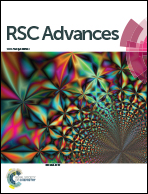The effect of different surface treatment methods on the physical, chemical and biological performances of a PGA scaffold
Abstract
In order to improve the adhesion between a PGA scaffold and islet cells, it is necessary to find a suitable method to modify the scaffold. In this study, the PGA scaffold surface was modified by plasma, polylysine coating and plasma combined with polylysine coating (P–P-PGA). The surface adhesion of the modified PGA scaffold was examined, and the stretchability and infiltration of the PGA scaffold were also tested. Then, the PGA scaffold treated under the optimal treatment conditions was selected to co-culture with rat islet cells, and the survival activity of the rat islet cells on the untreated PGA scaffold and the P–P-PGA scaffold was examined via the MTT method. Rhodamine staining and DAPI staining were used to detect the number of islet cells adhered to four groups of scaffolds at different culture time points. The PGA-islet graft in the leg muscle of rats was stained with HE to perform the PGA-islet graft pathological examination. The experimental results showed that when the plasma treatment power was 240 W, the processing time was 4 min; the concentration of the polylysine coating solution was 2 mg ml−1, the tensile strength of the PGA scaffold was 320.45 MPa and the amount of infiltration of the PGA scaffold by the serum medium presented the maximum value: 3.17 g g−1. The MTT survival activity test results showed that after 3 d of culture, the survival activity of the islet cells of the treated PGA scaffold culture group (2.02 ± 0.13) was significantly different from the survival activity of the islet cells of the untreated PGA scaffold culture group (1.93 ± 0.10). The survival activities of the islet cells in the experimental groups (1.60 ± 0.13, 1.40 ± 0.12) were still higher than those of the control groups (0.96 ± 013, 0.69 ± 0.09) at 15 and 21 d. The results of the rhodamine and DAPI staining showed that with the increase in culture time, the number of the adherent cells in each group increased, and the number of the adherent islet cells in the experimental group was higher than that in the untreated group. The HE staining results showed that the islet cells on the P–P-PGA scaffold were more than those on the untreated PGA scaffold. After modification of the PGA scaffold, the adhesion of the islet cells improved, which was conducive to the growth of islet cells. These results confirmed that the plasma combined with polylysine coating treatment could enhance the adhesion of the PGA scaffold surface, so that the scaffold and the islet cells exhibited better adhesion and biocompatibility, and the modified PGA scaffold (P–P-PGA) could be used as a promising islet cell scaffold.



 Please wait while we load your content...
Please wait while we load your content...